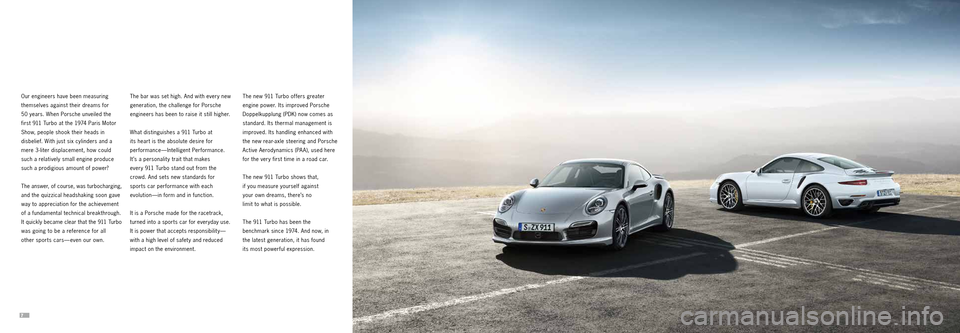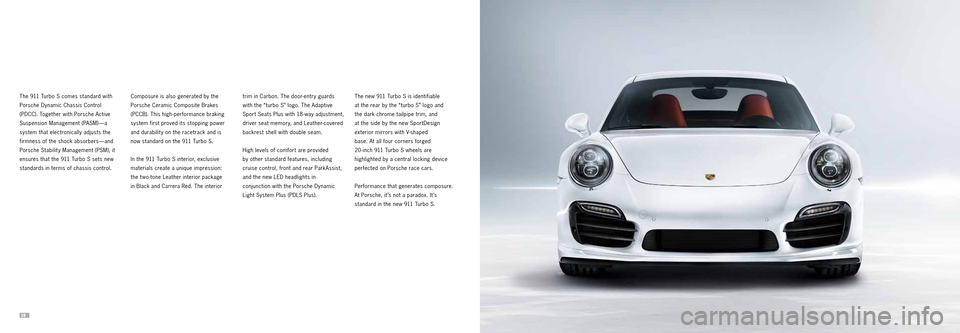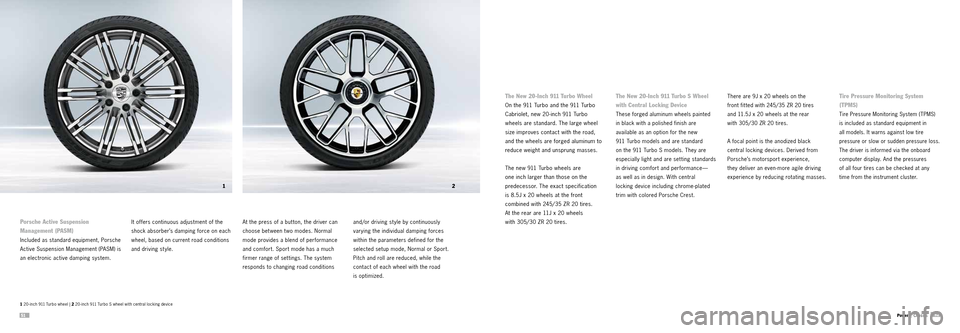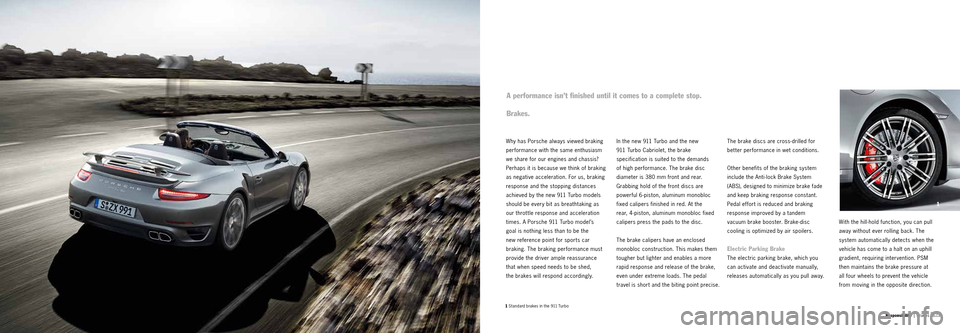ABS PORSCHE 911 TURBO 2013 6.G Information Manual
[x] Cancel search | Manufacturer: PORSCHE, Model Year: 2013, Model line: 911 TURBO, Model: PORSCHE 911 TURBO 2013 6.GPages: 59, PDF Size: 5.96 MB
Page 5 of 59

78
Our engineers have been measuring
themselves against their dreams for
50 years. When Porsche unveiled the
first 911 Turbo at the 1974 Paris Motor
Show, people shook their heads in
disbelief. With just six cylinders and a
mere 3-liter displacement, how could
such a relatively small engine produce
such a prodigious amount of power?
The answer, of course, was turbocharging,
and the quizzical headshaking soon gave
way to appreciation for the achievement
of a fundamental technical breakthrough.
It quickly became clear that the 911 Turbo
was going to be a reference for all
other sports cars— even our own.The bar was set high. And with every new
generation, the challenge for Porsche
engineers has been to raise it still higher.
What distinguishes a 911 Turbo at
its heart is the absolute desire for
performance—Intelligent Performance.
It ’s a personalit y trait that makes
every 911 Turbo stand out from the
crowd. And sets new standards for
sports car performance with each
evolution—in form and in function.
It is a Porsche made for the racetrack,
turned into a sports car for everyday use.
It is power that accepts responsibilit y—
with a high level of safet y and reduced
impact on the environment. The new 911 Turbo offers greater
engine power. Its improved Porsche
Doppelkupplung (PDK) now comes as
standard. Its thermal management is
improved. Its handling enhanced with
the new rear-axle steering and Porsche
Active Aerodynamics (PA A), used here
for the very first time in a road car.
The new 911 Turbo shows that,
if you measure yourself against
your own dreams, there’s no
limit to what is possible.
The 911 Turbo has been the
benchmark since 1974. And now, in
the latest generation, it has found
its most powerful expression.
Page 11 of 59

1920
The 911 Turbo S comes standard with
Porsche Dynamic Chassis Control
(PDCC). Together with Porsche Active
Suspension Management (PASM)—a
system that electronically adjusts the
firmness of the shock absorbers—and
Porsche Stabilit y Management (PSM), it
ensures that the 911 Turbo S sets new
standards in terms of chassis control.Composure is also generated by the
Porsche Ceramic Composite Brakes
(PCCB). This high-performance braking
system first proved its stopping power
and durabilit y on the racetrack and is
now standard on the 911 Turbo S.
In the 911 Turbo S interior, exclusive
materials create a unique impression:
the two-tone Leather interior package
in Black and Carrera Red. The interior trim in Carbon. The door-entry guards
with the “ turbo S” logo. The Adaptive
Sport Seats Plus with 18-way adjustment,
driver seat memory, and Leather-covered
backrest shell with double seam.
High levels of comfort are provided
by other standard features, including
cruise control, front and rear ParkAssist,
and the new LED headlights in
conjunction with the Porsche Dynamic
Light System Plus (PDLS Plus).The new 911 Turbo S is identifiable
at the rear by the “ turbo S” logo and
the dark chrome tailpipe trim, and
at the side by the new SportDesign
exterior mirrors with V-shaped
base. At all four corners forged
20 -inch 911 Turbo S wheels are
highlighted by a central locking device
perfected on Porsche race cars.
Performance that generates composure.
At Porsche, it ’s not a paradox. It ’s
standard in the new 911 Turbo S.
Page 27 of 59

5152
12
Power | Chassis
1 20 - inch 911 Turbo wheel | 2 20 - inch 911 Turbo S w heel with central locking device
It offers continuous adjustment of the
shock absorber’s damping force on each
wheel, based on current road conditions
and driving st yle. At the press of a but ton, the driver can
choose bet ween t wo modes. Normal
mode provides a blend of performance
and comfort. Sport mode has a much
firmer range of set tings. The system
responds to changing road conditions and/or driving st yle by continuously
varying the individual damping forces
within the parameters defined for the
selected setup mode, Normal or Sport.
Pitch and roll are reduced, while the
contact of each wheel with the road
is optimized. Porsche Active Suspension
M
anagement (PASM)
Included as standard equipment, Porsche
Active Suspension Management (PASM) is
an electronic active damping system.
The New 20-Inch 911 Tu rbo Wheel
On the 911 Turbo and the 911 Turbo
Cabriolet, new 20-inch 911 Turbo
wheels are standard. The large wheel
size improves contact with the road,
and the wheels are forged aluminum to
reduce weight and unsprung masses.
The new 911 Turbo wheels are
one inch larger than those on the
predecessor. The exact specification
is 8.5J
x 2
0 wheels at the front
combined with 245/35 ZR 20 tires.
At the rear are 11J x 20 wheels
with 305/30 ZR 20 tires.
The New 20-Inch 911 Tu rbo S W heel
with Central Locking Device
These forged aluminum wheels painted
in black with a polished finish are
available as an option for the new
911 Turbo models and are standard
on the 911 Turbo S models. They are
especially light and are set ting standards
in driving comfort and performance—
as well as in design. With central
locking device including chrome-plated
trim with colored Porsche Crest. There are 9J x 20 wheels on the
front fit ted with 245/35 ZR 20 tires
and 11.5J x 20 wheels at the rear
with 305/30 ZR 20 tires.
A focal point is the anodized black
central locking devices. Derived from
Porsche’s motorsport experience,
they deliver an even-more agile driving
experience by reducing rotating masses.
Tire Pressure Monitoring System
(TPMS)
Tire Pressure Monitoring System (TPMS)
is included as standard equipment in
all models. It warns against low tire
pressure or slow or sudden pressure loss.
The driver is informed via the onboard
computer display. And the pressures
of all four tires can be checked at any
time from the instrument cluster.
Page 28 of 59

5354
1
2 2
1 Fast cornering with the 911 Tu
rbo without PDCC (i llustration) |
2 Fast cornering with the 911 Tu rbo S w ith PDCC (illustration)
PDCC optimizes camber using
hydraulic stabilizing actuators in
the form of cylinders. Lateral roll is
counteracted by forces generated
at each individual wheel, based on
steering angle and lateral acceleration.
How does this translate to the
driving experience? More dynamic
performance with optimized turn-in and
stable load transfer characteristics.
And increased ride comfort. Porsche Stability Management (PSM)
All new 911 Turbo models come with
enhanced Porsche Stability Management
(PSM). It helps maintain stability
even at the limits of dynamic driving
performance. Sensors continuously
monitor the direction, speed, yaw
velocit y, and lateral acceleration of
the car. Using this information, PSM is
able to calculate the actual direction of
travel at any given moment. If the car
begins to oversteer or understeer, PSM
applies selective braking on individual
wheels to help restore stability.
Porsche Dynamic Chassis Control
(PDCC)
Porsche Dynamic Chassis Control (PDCC)
is standard on 911 Turbo S models and
available as an option on 911 Turbo
models. PDCC is an active anti-roll
system that suppresses lateral body
movement during cornering maneuvers
and helps minimize the lateral instability
of the vehicle on uneven ground. The
result is a car with improved roadholding
and more dynamic performance.
Under acceleration on wet or low-grip
road surfaces, PSM improves traction
using the Automatic Brake Differential
(ABD) and Anti-Slip Regulation (ASR).
When the Sport Plus mode of the
Sport Chrono Package is selected,
the PSM threshold is raised to allow
a more assertive driving st yle.
PSM can be deactivated. But for your
safety, it is automatically reactivated
only if you brake hard enough that
either of the front wheels (in Sport
Plus mode, both of the front wheels)
requires ABS (Anti-lock Brake
System) assistance. ABS and ABD,
however, remain active at all times.
1
Page 32 of 59

6162
1
Responsibility | Brakes
1 Standard brakes in the 911 Turbo
Why has Porsche always viewed braking
performance with the same enthusiasm
we share for our engines and chassis?
Perhaps it is because we think of braking
as negative acceleration. For us, braking
response and the stopping distances
achieved by the new 911 Turbo models
should be every bit as breathtaking as
our throt tle response and acceleration
times. A Porsche 911 Turbo model’s
goal is nothing less than to be the
new reference point for sports car
braking. The braking performance must
provide the driver ample reassurance
that when speed needs to be shed,
the brakes will respond accordingly. In the new 911 Turbo and the new
911 Turbo Cabriolet, the brake
specification is suited to the demands
of high performance. The brake disc
diameter is 380 mm front and rear.
Grabbing hold of the front discs are
powerful 6-piston, aluminum monobloc
fixed calipers finished in red. At the
rear, 4-piston, aluminum monobloc fixed
calipers press the pads to the disc.
The brake calipers have an enclosed
monobloc construction. This makes them
tougher but lighter and enables a more
rapid response and release of the brake,
even under extreme loads. The pedal
travel is short and the biting point precise. The brake discs are cross-drilled for
better performance in wet conditions.
Other benefits of the braking system
include the Anti-lock Brake System
(ABS), designed to minimize brake fade
and keep braking response constant.
Pedal effort is reduced and braking
response improved by a tandem
vacuum brake booster. Brake-disc
cooling is optimized by air spoilers.
Electric Parking Brake
The electric parking brake, which you
can activate and deactivate manually,
releases automatically as you pull away.
A performance isn’t finished until it comes to a complete stop.
Brakes.
With the hill-hold function, you can pull
away without ever rolling back. The
system automatically detects when the
vehicle has come to a halt on an uphill
gradient, requiring intervention. PSM
then maintains the brake pressure at
all four wheels to prevent the vehicle
from moving in the opposite direction.
Page 36 of 59

6970 Responsibility | Environment
Recycling
For both technical and ecological
reasons, intelligent lightweight
construction has been fundamental to
Porsche since our first car in 1948.
This forms the basis for achieving low
fuel consumption values in conjunction
with outstanding performance.
On the technical side, we use a high
proportion of aluminum, magnesium,
plastics, and super high-strength sheet
steel. The materials used have been
selected for their ability to withstand
load, yet they are considerably
lighter than conventional steel.On the ecological side, all materials used
are meticulously selected. All synthetic
components are easily recyclable. And
each material is labeled to facilitate its
separation for recycling. The reduction
in the number of plastic variants helps to
ensure more efficient recycling. Recycled
plastics are used where they meet our
exacting technical requirements.
In short, the new 911 Turbo models are
approximately 95 percent recyclable.
In addition, Porsche uses a high
proportion of environmentally
friendly water-based paints. For us,
environmental protection does not begin
at the end of a vehicle’s life. It starts at
the planning and development stage. having the same fuel economy of 17 mpg
in the cit y and 24 mpg on the highway.
Noise
The 911 Turbo models and the new
911 Turbo S comply with all current
noise regulations—without resorting
to engine encapsulation. To achieve
this, we’ve eliminated noise at the
source: Engine components are
more rigid, moving parts lighter,
and tolerances reduced to a
minimum. High-efficiency silencers
and resonators in the intake system
help to reduce noise even further.
Fuel
All Porsche models are designed to
operate on fuels with an ethanol content
of up to 10 percent. Ethanol has a positive
impact on the CO
2 balance since the plants
grown for the production of this biofuel
also absorb CO
2 from the atmosphere.
The release of hydrocarbons from the fuel
system has been minimized, thanks in no
small part to the active carbon filter and the
multilayered material from which the fuel
tank is made. All fuel lines are made from
multilayered plastic, steel, or aluminum.
The new 911 Turbo models have
maximized the fuel-saving technologies,
which results in all the 911 Turbo models